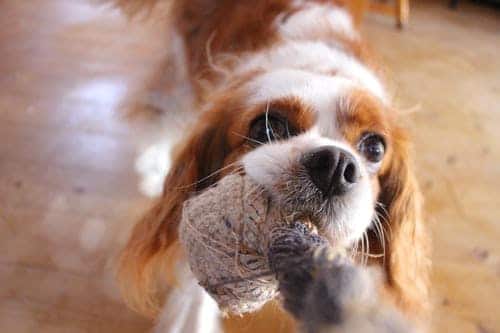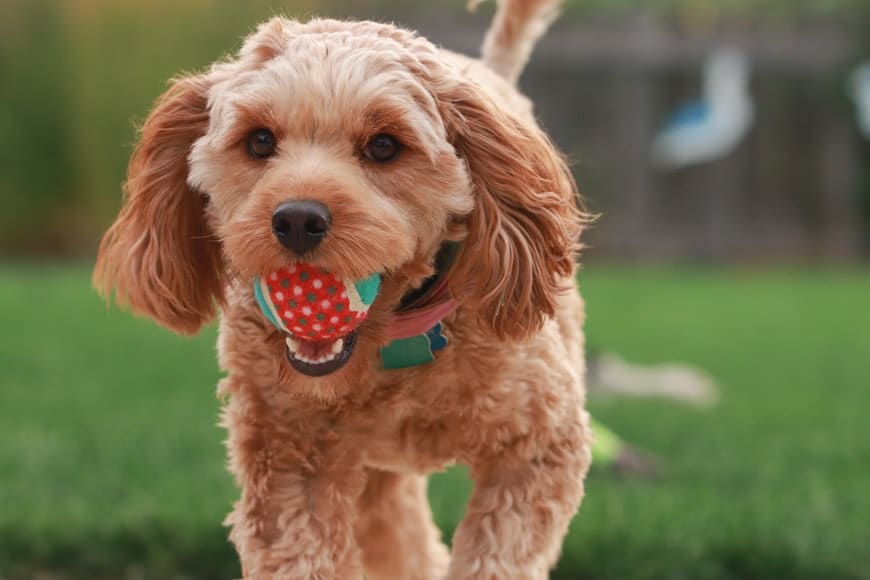

Cavalier King Charles Spaniels and Cavapoos, also known as Cavadoodles, are quite similar, given that, by definition, a Cavapoo has a Cavalier as one of its parents. Both breeds are amazing companion dogs but have differences that can be important for prospective owners.
Cavaliers and Cavapoos are happy, friendly, bright companion dogs that are great for almost any household. Cavapoos are a better match for active people who enjoy training their pets. Cavapoos are also healthier and may be less likely to trigger allergies in sensitive people. Cavalier King Charles Spaniels are a more established breed, famous for being amazing therapy and support animals. They are docile and gentle and do very well with young kids.
There are several important criteria to consider when choosing a breed for your household.
Overview of the Breeds
| Breed | Cavalier | Cavapoo |
| Size | 12-15 in (30-38 cm) | 10-14 in (25-36 cm) |
| Weight | 12-20 lbs (5.5-9 kg) | 10-25 lbs (5.5-11 kg) |
| Life expectancy | 9-14 years | 12-15 years |
| Coat colors | Blenheim (chestnut, white), tri-color (black, white, tan), ruby, black and tan | cream, fawn, brown, gold, white; can come in solid or two and tri-color |
| Exercise needs | low to moderate | moderate |
| Suitable for children | yes, good with young kids | yes, especially school-age kids |
| Hypoallergenic | no | no, but can be less allergenic |
Brief Histories of the Breeds
Cavaliers are a toy breed but with good athletic potential. They were popular among royalty in England in the 17th century but their features kept changing over the centuries, due to selective breeding.
King Charles The First was so fond of the breed that he decreed that these pups were allowed in all public buildings. Bred primarily as companion dogs, they did accompany the owners on hunting trips too, so these pets are surprisingly sporty when they want to be.
Cavapoos emerged as a designer breed in the late 1990s in Australia. They are a cross between Cavalier King Charles spaniels and poodles, usually miniature ones.
Cavapoos are smart and, although a toy breed, athletic. Cavapoos can resemble one or the other parent more or appear as a blend of both breeds equally. Behavior and intelligence usually take after the breed the puppy resembles more.
Intelligence, Response to Training
Cavaliers are at the top of the average group ranked by intelligence, specifically working intelligence.
That level of intelligence is great for family pets because it means that the dog is good at learning commands and new skills but not so smart that it needs to be mentally stimulated at all times. These pups love to play and run around but also enjoy taking a long nap by your side while you are watching a movie.
Since Cavapoos are half poodles, they could be more intelligent and faster at grasping commands and skills than Cavaliers. They are also docile and mellow enough to tolerate an idle day well. Most Cavapoos are happy spending time at home, and watching a movie with the family, just like Cavaliers.
Energy Level, Activity Needs
Both breeds are quite active but tolerate lazy days as needed. Cavapoos are usually more sporty, thanks to their poodle heritage. A good thirty-minute daily walk is enough for both Cavapoos and Cavaliers but a Cavapoo appreciates getting more exercise.
A dog of any breed can be quite hyper at a young age. A Cavapoo is more likely to make you wonder what age it will finally calm down a little.
Both breeds enjoy games and do well with water activities, easy hikes, and dog parks. Dogs of these breeds are very sociable, so activities in crowded places do not pose challenges.
Both breeds are great for families with kids because they are flexible with their activity needs.
Temperament
Cavaliers and Cavapoos share an amiable disposition and bubbly behavior. Both breeds are affectionate with all family members and enthusiastic to partake in any game or adventure.
Cavaliers tend to be more clingy and owner-oriented. Poodle heritage makes Cavapoos more independent and curious about the world around them. A Cavalier is typically friendly with anyone it meets but a Cavapoo could be more cautious, especially with new dogs.
If You Have Allergies
Cavaliers are not considered to be hypoallergenic.
Cavapoos may have a lower allergenic potential. Poodles are considered hypoallergenic, although there is no guarantee that they will not cause a reaction in a sensitive individual. Because Cavapoos are 50% poodles, they could be less likely to cause an allergic reaction.
It is important to spend some time with the dog to test if you have allergies. An hour, usually less than that, is often enough to trigger a reaction.
The Dog and Kids
Dogs of both breeds are wonderful pets for families with children.
Cavaliers are great with children of all ages but could be a better fit for younger kids.
A Cavapoo could be a better match for school-age kiddos because the pups of this breed are especially fun to train and are usually more athletic than Cavaliers. Older children may enjoy interacting with Cavapoos more, although there is plenty of variation within a breed and children’s temperaments.
The Dog and Other Pets
Cavaliers are very mellow and get along with cats, dogs, and other pets, provided that the other pets are also friendly. A Cavapoo is likely to do just fine with other pets in the household but they are more likely to be opinionated and loud.
A Cavapoo is more likely to see a small animal as prey, so they should be supervised around small pets, such as rodents. Cavaliers, however, can have similar behaviors around hamsters and other rodent pets
Any Behavioral Issues?
Neither Cavapoos nor Cavaliers are known for any particular misbehaviors or undesirable traits.
Cavalier King Charles spaniels are intolerant of being alone and many dogs of this breed develop separation anxiety. It is something to consider if your pet is likely to spend long hours alone when the human family is at work or school. Having other pets in the house is helpful in that realm.
Cavapoos are less likely to develop separation anxiety but may still struggle with being alone due to boredom. Have a variety of puzzles and toys for these dogs because they need to keep their minds busy.
Some Cavapoos are very vocal, so barking could become an issue. Luckily, they are easy to train and the problem can be addressed effectively.
Sensitivity to Temperature Extremes
Neither of these two breeds does well with temperature extremes.
Cavalier King Charles spaniels are brachycephalic so they are especially intolerant of hot weather but they also do poorly with the cold.
Cavapoos often have at least some of the brachycephalic features, more or less pronounced, so these designer pups are also very heat-sensitive.
Both breeds have single-layer coats that are not waterproof and do not protect them well against harsh weather conditions.
Grooming Needs and Shedding
Cavapoos’ coats could have very different qualities, depending on which parent the Cavapoo puppy resembles more. The fur could be long and quite straight or short and wavy. Cavapoos shed less than Cavaliers do, which is why many people believe them to be hypoallergenic, which is not the case.
Most owners get their dogs’ coats trimmed by a groomer about every 6 weeks. Daily brushing is a good way to prevent matting, especially if the coat is curly.
Cavaliers are more likely to shed moderate amounts of fur regularly and benefit from regular brushing, at least a few times a week. Most owners of these pups also take them to professional groomers every couple of months.
Health Issues
Cavapoo dogs are healthier, in general than Cavalier King Charles Spaniels. That, of course, translates into lower veterinarian bills for Cavapoos.
Cavalier King Charles Spaniels are among the most expensive breeds to purchase pet health insurance for because several health conditions are common for these pups.
- Mitral Valve Disease (MVD) begins as a heart murmur and progresses into heart failure. Early diagnosis allows managing the condition to prolong the expectancy of the dog’s life and improve its quality
- Syringomyelia (SM) affects the brain and spine. Symptoms start between 6 months and 4 years and range from mild discomfort to severe pain and/or partial paralysis.
- Hip dysplasia is common for dogs in general. Cavaliers with hip dysplasia might need pain medications but many continue to lead normal, happy lives, with some activity adjustments.
- Seizure Disorder: onset is between 6 months and 3 years. The dog may need lifelong medications and occasional testing to keep the seizures under control.
- Cataracts are common for older dogs and cause blindness. Surgery to remove cataracts and restore sight could be an option. Most dogs adjust to losing sight and live happily, with proper care.
Cavapoos have their concerns when it comes to health risks, although they are at a lower risk for genetically inherited disorders, including seizure disorder, cataracts, and hip dysplasia.
- Progressive Retinal Atrophy (PRA) is another relatively common condition for these dogs. It begins as night blindness and eventually progresses to total blindness.
Some of these conditions can be screened for, and responsible breeders avoid breeding animals with known genetic health problems.
To Sum Up
The characteristics of your family are just as important to consider when looking for the right dog for you or your family.
Cavalier King Charles spaniels and Cavapoos are quite similar but there is also a great variation of personalities within a particular breed.
Consider visiting your local shelter because they could have dogs of specific breeds who need a home. Adopting a grown-up dog allows one to see the animal’s personality and circumvent the need to train a puppy. Shelter volunteers and staff often provide a personality report about the animal, which is not something a breeder or a pet store could o
Recent Posts
Many dogs are prone to chasing and even nipping cats and other smaller animals. It is a problem when your dog meets a cat outside. It is an even bigger problem if your dog chases and herds your...
Owners of corgis sometimes hesitate to involve their pets in intense exercise due to these dogs’ physiques. However, corgis are athletic dogs and there are several great options for activities and...

